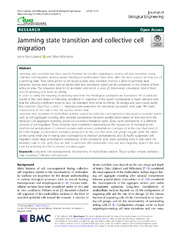Приказ основних података о документу
Jamming state transition and collective cell migration
| dc.creator | Pajić-Lijaković, Ivana | |
| dc.creator | Milivojević, Milan | |
| dc.date.accessioned | 2021-03-10T13:56:21Z | |
| dc.date.available | 2021-03-10T13:56:21Z | |
| dc.date.issued | 2019 | |
| dc.identifier.issn | 1754-1611 | |
| dc.identifier.uri | http://TechnoRep.tmf.bg.ac.rs/handle/123456789/4087 | |
| dc.description.abstract | Jamming state transition has been used in literature to describe migrating-to-resting cell state transition during collective cell migration without proper rheological confirmation. Yield stress often has been used as an indicator of a jamming state. Yield stress points to the liquid-to-solid state transition, but not a priori to jamming state transition. Various solid states such as elastic solid and viscoelastic solids can be considered in the context of their ability to relax. The relaxation time for (1) an elastic solid tends to zero, (2) Kelvin-Voigt viscoelastic solid is finite, and (3) jamming state tends to infinity. In order to clarify the meaning of jamming state from the rheological standpoint we formulated the constitutive model of this state based on following conditions (1) migration of the system constituents is much damped such that the diffusion coefficient tends to zero, (2) relaxation time tends to infinity, (3) storage and loss moduli satisfy the condition G(')(omega)/G(")(omega) = const gt 1. Jamming state represents the non-linear viscoelastic solid state. The main characteristic of this state is that the system cannot relax. Jamming state transition of multicellular systems caused by collective cell migration is discussed on a model system such as cell aggregate rounding after uni-axial compression between parallel plates based on the data from the literature. Cell aggregate rounding occurs via successive relaxation cycles. Every cycle corresponds to a different scenario of cell migration. Three scenarios were established depending on the magnitude of mechanical and biochemical perturbations (1) ordered scenario with reduced perturbations corresponds to the case that most of the cells migrate, (2) disordered scenario corresponds to the case that some cell groups migrate while the others (at the same time) stay in resting state (corresponds to medium perturbations), and (3) highly suppressed cell migration under large perturbations corresponds to the viscoelastic solid under jamming state. If cells reach the jamming state in one cycle, they are able to overcome this undesirable state and start migrating again in the next cycle by achieving the first or second scenarios again. | en |
| dc.publisher | Bmc, London | |
| dc.relation | info:eu-repo/grantAgreement/MESTD/Integrated and Interdisciplinary Research (IIR or III)/46001/RS// | |
| dc.rights | openAccess | |
| dc.rights.uri | https://creativecommons.org/licenses/by/4.0/ | |
| dc.source | Journal of Biological Engineering | |
| dc.subject | Long-time cell rearrangement | en |
| dc.subject | Viscoelasticity of multicellular surfaces | en |
| dc.subject | Tissue surface tension | en |
| dc.subject | Jamming state transition | en |
| dc.subject | Collective cell migration | en |
| dc.title | Jamming state transition and collective cell migration | en |
| dc.type | article | |
| dc.rights.license | BY | |
| dc.citation.issue | 1 | |
| dc.citation.other | 13(1): - | |
| dc.citation.rank | M21 | |
| dc.citation.volume | 13 | |
| dc.identifier.doi | 10.1186/s13036-019-0201-4 | |
| dc.identifier.fulltext | http://TechnoRep.tmf.bg.ac.rs/bitstream/id/9869/s13036-019-0201-4.pdf | |
| dc.identifier.pmid | 31516549 | |
| dc.identifier.scopus | 2-s2.0-85072023562 | |
| dc.identifier.wos | 000484625200001 | |
| dc.type.version | publishedVersion |

